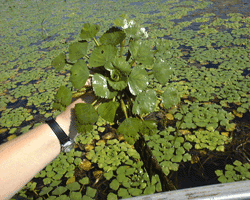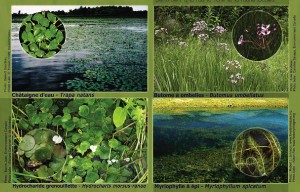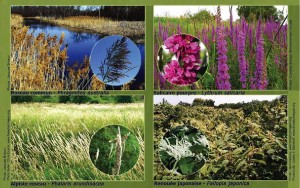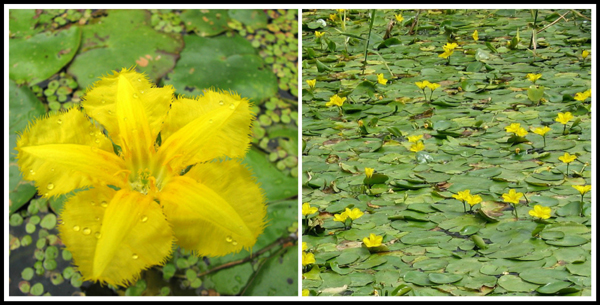Invasive and exotic aquatic plants
The aquatic plants may purify the water column, but the subject is far from crystal clear regarding invasive aquatic plants, that most don’t want clogging up shorelines, ruining swimming holes, tangling up propellers and tripping water skiers.

What are exotic invasive plant species?
Exotic means that the plants come from another country or region. If these plants don’t have natural enemies here, they will proliferate to a point where they will take over indigenous (native) species that do have natural enemies. These opportunistic plants are called invasive.
What to do about invasive aquatic weeds in your pond?
- Identify the invasive aquatic weeds you have in your pond to make sure you are not trying to remove native (indigenous) aquatic plants that are beneficial to your ecosystem. There are many online resources to help you with this. If you are in public waters (a lake or river) be particularly careful, as you could be fined heavily for removal of native aquatic habitat. Keep an eye on your pond and notice when new non-native aquatic weeds take hold. This is your best chance to get rid of them before they really get established.
- Get in the pond and pull the young shoots by hand or use the Razor and Weed Rake to get the plant material out of the pond. Remember to not dispose of the plant in your compost bin or compost site. This is an invasive plant that has to be sent to landfill. Apply a benthic barrier for 4-5 weeks to permanently kill roots of dense populations.
- If you can’t do previous step, try to remove the seed heads when they appear. Cut the brown seed pods from cattails before they pop, and compost them away from the pond. Aquatic non-native invasive species can reproduce by seed, by tuber, and by rooting leaf debris; they are very adept at taking over aquatic real estate.
- Once you have removed the exotic invasive species, plant indigenous aquatic plants in the open space. The goal is to create more native habitat to compete with the non-native aquatic plants. Plant densely if possible and keep on weeding the unwanted plants as they appear. You can find a list of indigenous plants recommended for watersheds HERE. Contact a local nursery that grows indigenous aquatic plants and order small plugs in large quantity for greatest value.
- If all of this seems overwhelming, try the long term approach. Lay down bubble tubing among the weeds to provide aeration from the bottom up. Use beneficial bacteria to help consume the nutrient rich sediment that feeds the aquatic plants. Remove the plant material with the Weed Rake and Razor once they start showing signs of decline (August), and compost away from the water. By doing these things, you will be removing the nutrients in the sediment that feed the algae & plants; the plants take up phosphorus from the sediment and store it in the fibre, so by removing the plant, you remove that particular nutrient cycle. Also, less muck equals less substrate for the plants to grow in.
- What if you just have too many weeds already, too much shoreline to manage? Then focus on one area to allow you access to a small beach, a dock, or the rest of the lake.

Some invasive aquatic plants to watch for
Here are 8 invasive aquatic plants (pictured on the 2 images below) that you should definitely be cautious about:
- Flowering Rush, Butomus Umbellatus
- Purple Loosestrife, Lythrum Salicaria
- European Frogbit, Hydrocharis Morsus-Ranae
- Reed Canary Grass, Phalaris Arundinacea
- Common Reed, Phragmites Australis
- Eurasian Water Milfoil, Myriophyllum Spicatum
- Water chesnut, Trapa Natans
- Knowtweed, Fallopia Japonica
If you can read French, we suggest consulting the French version of this page to read more about these specific plants and their alternatives.


Water fringe, an aquatic plant you don’t want to see in your pond!
But unfortunately, Nymphoides peltata (also known as water fringe or yellow floating heart) is widely available in garden center. Don’t make the mistake of purchasing it as it spreads around very easily and little is known for the control of this species and no biological control is known.

- It kills fish and underwater plants by taking most of the oxygen from the water.
- It also kills fish by taking sunlight from plants which is their food source. Larger fish then die because the smaller fish are their food source.
- It keeps us from from canoeing, kayaking, and swimming in our ponds because the roots are stiff and hard to evade.
- It costs millions of dollars to prevent and impacts tourist industry
There are solutions available, in the form of aquatic weed control tools, bio-augmentation and aeration systems, but they do require physical work and patience. Do not hesitate to contact us to find out more!